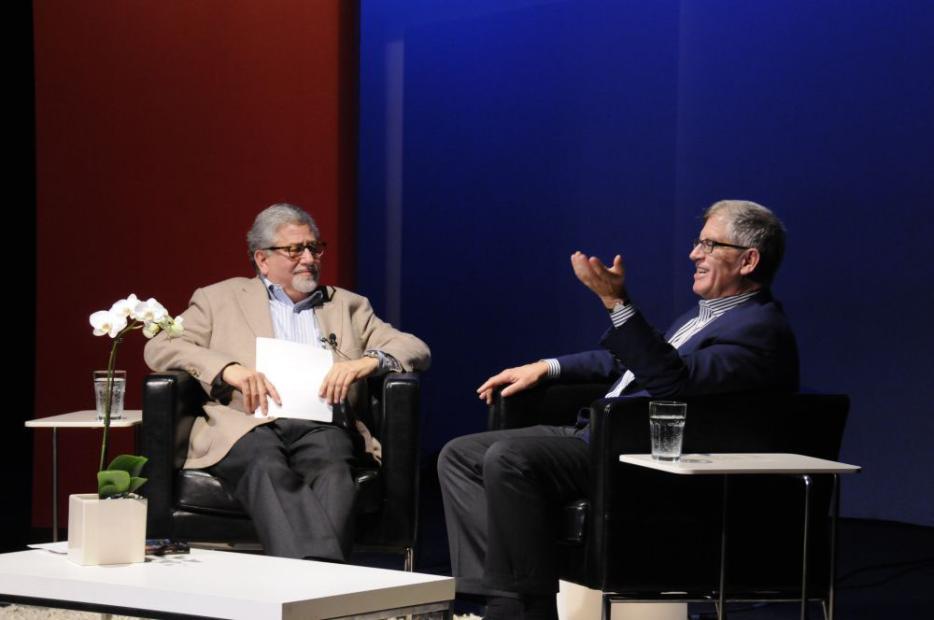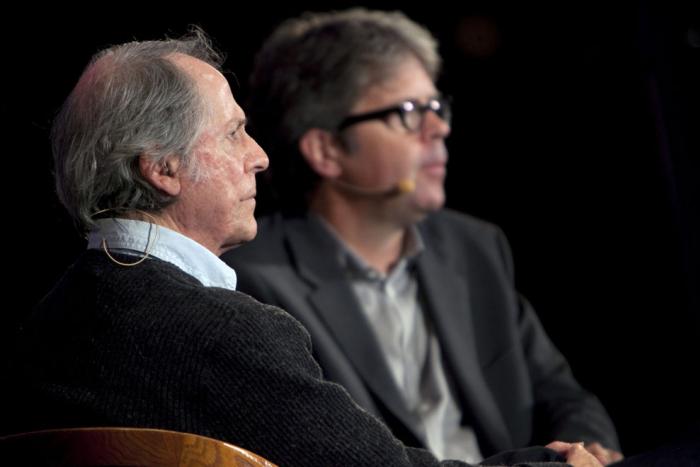Monday, October 22
John Galassi interviewed by David Kent, hosted by Sarah MacLachlan
The line is very long and populated by practically every person working in publishing in the city of Toronto. They are a well dressed bunch, and given the amount of professional partying to be done this month it makes sense that the crowd seems a little fancier than the average IFOA event’s audience.
Sarah MacLachlan, publisher of Canada’s largest independent press, House of Anansi, introduces the guests and reads the house rules. David Kent, the president of Harper Collins Canada, and Jonathan Galassi, the president of Farrar Strauss and Giroux, take the stage. “I’m not a professional interviewer,” Kent tells us, before adding that he hopes the ensuing discussion will be of particular interest to the young and mid-career publishing folks in the crowd. I wonder if I’m the only member of the audience who thinks of the business of publishing books as primarily a spectator’s sport.
The bespectacled men chat easily and knowledgeably, falling in and out of New York nostalgia. Every time one of them makes use of a Yiddishism, Kent slides us an aside: “Schmutz—That’s a publishing expression.” During the audience Q&A, someone brusquely demands to know why publishers haven’t adapted to newer technologies, why big house e-books remain so expensive compared to self-published ones. Kent maneuvers to demur to Galassi, but finds himself piqued and instead delivers an impassioned retort: “There’s so much unseen value,” he says. “It bothers me that there is a person sitting in some Starbucks, drinking a $4 coffee, playing with a $600 tablet, wearing $200 jeans, wondering what makes Hilary Mantel worth more than $2.99!” A round of applause breaks out. Someone whistles.
*
Tuesday, October 23
Round Table: The Novel as Window onto Society
Simonetta Agnello Hornby, Emily St. John Mandel, Emily Schultz, and Linda Spalding, moderated by David Layton
By now people have noticed that I keep showing up, and I’m sidelined en route to the box office by another professional IFOA goer. I try to be polite, but I’m more anxious than usual to get to my seat; being affiliated with both of the Emilys—Schultz of Joyland, Mandel of The Millions—appearing on stage, I really want to have my choice of vantage points.
The room doesn’t quite fill, but the crowd never fidgets once everyone appears on stage. David Layton mixes up Emily St. John Mandel and Emily Schultz, but Schultz is quick to correct him. Layton describes the disparate texts penned by the women he’s there to interview—Simenetta Agnello Honby’s The Nun and Linda Spalding’s The Purchase are both historical novels featuring main characters conflicted by their own religious convictions in a shifting social world; Emily Schultz’s The Blondes and Emily St. John Mandel’s The Lola Quartet, feature contemporary characters dealing with worlds suddenly overturned by tumultuous events. Layton seems a little unprepared to address the thematic breadth represented by the novelists on stage, “What mad genius,” he asks, “has put these authors together?”
Layton takes a while formulating his questions, but eventually alights on a notion of change that might tether the conversation to the room. “You’re asking me about change?” Hornby asks. She says that when the Shah of Iran was ousted during the Islamic revolution, she celebrated the change, but then it only got worse. “We’re very stupid, human beings,” Hornby says. Spalding describes slavery, one of the central historical elements she explores in The Purchase, as having a very long shadow, adding “my God, we’ll never be rid of it.” Emily Schultz offers that things are always changing, it’s just that one doesn’t really notice because “when you’re sitting in the present you can’t look around.”
Layton surprises everyone with his next question, asking “does this kind of talk irritate you?” Schultz turns her face toward Mandel, letting her eyes go very wide. Layton wants to know if these kind of questions, presumably ones that investigate the ideas in the texts, are bothersome. Schultz thinks they enable discussions without giving away too much of the plot in a festival setting, one where many attendees may not have read the books. Mandel says that, ideally, a novel should not function as a delivery system for a moralizing idea, “you have to lay out the story and make the characters as human as possible.” Everyone nods.
*
Wenesday, October 24
Round Table: Basic Instinct, Style vs. Content
Marjorie Celona, Rebecca Lee, Anakana Schofield, and Leanne Shapton, moderated by Susan G. Cole
I arrive very early, and sit at a small round table near the front. Soon a local novelist whose work I admire joins me and I unthinkingly say something embarrassing. A poet joins us. And then another novelist whose work I haven’t read. I think about whether it’s wise or not to sit among so many writers at a literary festival. As we wait for the event to begin, the novelists talk about festivals they’ve attended, panels they’ve sat on. The poet describes the nervous quality of the space, saying he’d been on this stage and it is indeed the most anxious one at Harbourfront. The room grows very full, and the first novelist says that perhaps this event is drawing everyone else because it’s the one billed as being specifically about craft.
If the moderator of the previous night’s event was slack and unprepared, taking up more than 1/5th of the time allotted to ask questions of his four guests, then Susan G. Cole’s approach seems a bit too tight. She asks careful questions of each of author on stage, and it’s not until well past the halfway point that the authors really enter into conversation with each other. Cole asks Rebecca Lee to describe the connecting thread that runs through Bobcat, her collection of short stories. Lee describes the process of writing, which she borrowed from an idea more conventionally applied to architecture, “the beginning is a dream, and you build with the rules in mind, but the building isn’t complete. It eventually belongs to the people who live in it.” Cole asks Leeane Shapton about the impulse behind her memoir, Swimming Studies, and Shapton describes the desire to find some space for her previous life. “I wanted,” she tells us, “to figure out how to enjoy the water in a different way.” Marjorie Celona, when prompted, describes finding her story in her ability to distract herself, to fixate on things that are outside of what’s really supposed to be going on. She talks about the orchid sitting on stage, the letter “Y”, and the first line of her novel jumping into her head. Anakana Schofield describes her ambitions with her novel, Malarky, as a way of showing the accumulative nature of grief. “I wanted to tattoo something on the page that spoke to that, and I could only do it fragments.”
For the most part, there is very polite back and forth between Cole and each writer. The crowd starts to fidget, imperceptibly at first, though I gradually become aware of the sounds of program pages being turned, knees jostling, and tickets being absentmindedly torn into tiny squares. Things only start to heat up once the authours start speaking about more than just their own discrete books, once the stakes have been raised. Celona describes her distaste for too much style, for sentences that she thinks get in the way of story, which she characterizes as a writer “showing off.” She tells an anecdote from the time she spent in Iowa, presumably at the writer’s centre there, in which Michael Cunningham advised one of her peers to go over each of her sentences and assign them a grade. The writer was then to discard each sentence that had been graded an “A.” “I really believe that,” Celona says.
The first novelist at my table whispers, with some force, “Oh, I don’t agree at all.” Up on stage, Schofield says the same, but louder and with more emphasis: “Oh my God, I’m horrified!” Language, and style, are incredibly important to Schofield, and she says as both a reader and a writer she’s most intrigued “when someone is doing something stylized.” Rebecca Lee jumps in to say that some kinds of style are basically invisible, and she cites Alice Munro as the premier example. “You read each sentence on its own, and you think, ‘I could write that,’ but then you get to the end and she’s done something incredible, but it’s invisible.” Shapton jumps in with a useful distinction she’s learned from the visual art world. “There’s illustration, and there’s fine art,” she says, and perhaps it’s helpful to think of style in those terms. Illustration can be pretty, but art connotes the beauty of being challenged in an aesthetic or intellectual way as well. An audience member asks for further definition: “What do you each mean by ‘Content,’?” Shapton gets the last word: “It’s the art in it. It’s a nugget of awesome.”






